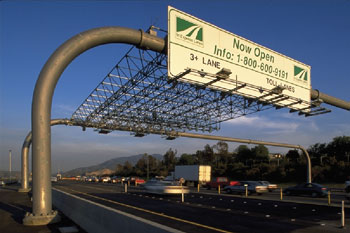Transit and Congestion Pricing
What Is Congestion Pricing?
Congestion pricing—sometimes called value pricing—is a way of harnessing the power of the market to reduce the waste associated with traffic congestion. Congestion pricing works by shifting purely discretionary rush-hour highway travel to other transportation modes or to off-peak periods, taking advantage of the fact that the majority of rush-hour drivers on a typical urban highway are not commuters. By removing a fraction (even as small as 5 percent) of the vehicles from a congested roadway, pricing enables the system to flow much more efficiently, allowing more cars to move through the same physical space. Similar variable charges have been successfully utilized in other industries, for example, airline tickets, cell phone rates, and electricity rates. There is consensus among economists that congestion pricing represents the single most viable and sustainable approach to reducing recurring traffic congestion.
Although drivers unfamiliar with the concept initially have questions and concerns, surveys show that drivers who have experienced congestion pricing support it. They do so because it offers them a reliable trip time, which is very valuable, especially when they have to be somewhere on time.
Effects of Pricing on Vehicle Throughput
Vehicle throughput on a freeway is the number of vehicles that get through a distance over a short period of time, such as an hour. Once freeway traffic exceeds a certain threshold level, both vehicle speed and vehicle throughput drop precipitously. Data show that maximum vehicle throughput occurs at free-flow speeds ranging from 45 mph to 65 mph. The number of vehicles that get through per hour can drop by as much as 50 percent when severe congestion sets in. At high-traffic levels, the freeway is kept in this condition of “collapse” for several hours after the rush of commuters has stopped. This causes further unnecessary delay for off-peak motorists who arrive after rush hour. With peak-period highway pricing, a variable toll dissuades some motorists from entering freeways at those access points where traffic demand is high and where such surges in demand may push the freeway over the critical threshold at which traffic flow collapses. Pricing prevents a breakdown of traffic flow in the first instance and thus maintains a high level of vehicle throughput during the rush hours.
Types of Congestion Pricing
There are five main types of pricing strategies:

Transponders are read by overhead antennas, allowing tolls to be paid without stopping.
- Variably priced lanes: Variable tolls on separated lanes within a highway, such as express-toll lanes or high-occupancy toll (HOT) lanes.
- Variable tolls on entire roadways: Both on toll roads and bridges, as well as on existing toll-free facilities during rush hours.
- Zone-based (area or cordon) charges: Either variable or fixed charges to drive within or into a congested area within a city.
- Area-wide charges: Per-mile charges on all roads within an area that may vary by level of congestion.
- Pricing that does not involve tolls: This includes innovative parking-pricing strategies (e.g., surcharges for entering or exiting a parking facility during or near peak periods) and a range of parking cash-out policies, in which cash is offered to employees in lieu of subsidized parking.
Benefits of Congestion Pricing
Congestion pricing benefits drivers and businesses by reducing delays and stress, by increasing the predictability of trip times, and by allowing for more deliveries per hour. It benefits state and local governments by improving the quality of transportation services without tax increases or large capital expenditures, by providing additional revenues for funding transportation, by retaining businesses and expanding the tax base, and by shortening incident response times for emergency personnel. By preventing the loss of vehicle throughput that results from a breakdown of traffic flow, pricing maximizes return on the public’s investment in highway facilities.
Congestion pricing also benefits public transportation by improving vehicle speeds and service reliability. This in turn increases public transportation ridership and lowers operating and maintenance costs. Public transportation and ridesharing advocates appreciate the ability of congestion pricing to generate both funding and incentives to make public transportation and ridesharing more attractive.
Use of Revenues From Pricing
Congestion pricing can generate substantial revenues from tolls. A portion of the revenues generated will be needed to operate the toll-collection and traffic-management systems. Net revenues after payment of operating costs can be used to pay for expansion of roadway facilities; to support alternatives to driving alone, such as public transportation; to address impacts on low-income individuals by providing toll discounts or credits; or to reduce other taxes that motorists pay for highways, such as fuel taxes, vehicle registration fees, or sales taxes.